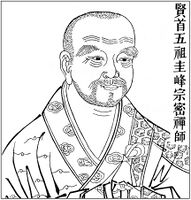Zongmi
Jump to navigation
Jump to search
| English Phonetics | Guifeng Zongmi |
|---|---|
| Chinese Script | 圭峰 宗密 |
| Chinese Transliteration | Guīfēng Zōngmì |
| Japanese Transliteration | Keihō Shūmitsu |
| Korean Transliteration | Kyubong Chongmil |
Dates
| Birth: | 780 |
|---|---|
| Death: | 841 |
| Place of birth: | Xichong, present-day Sichuan province |
Tibetan calendar dates
About
- Religious Affiliation
- Heze school of Chan
- Teachers
- Daoyuan · Nanyin Weizhong · Chengguan
Other Biographical info:
Links
- Wiki Pages
Buddha Nature Project
- Person description or short bio
- Guifeng Zongmi. (J. Keihō Shūmitsu; K. Kyubong Chongmil 圭峰 宗密) (780-841). Chinese Chan master and historian; putative fifth patriarch of the Huayan tradition and successor in the Heze school of Chan; best known for positing the fundamental harmony between the scriptural teachings of Buddhism and Chan practice. Zongmi was a native of Xichong in present-day Sichuan province. Although little is known of his early life, Zongmi is said to have received a classical Confucian education. In 804, Zongmi encountered the monk Daoyuan (d.u.), purportedly a fourth-generation lineage holder of the Heze line of Chan, and became his student. During this period, Zongmi also carried on his studies of the Yuanjue jing. In 808, Zongmi received the full monastic precepts from Daoyuan, who then recommended the monk Nanyin Weizhong (d. 821) as a suitable teacher. In 810, Zongmi met the monk Lingfeng (d.U.), a disciple of the Huayan monk Chengguan, at the monastery of Huijuesi. Two years later Zongmi began his studies of the Avataṃsakasūtra under Chengguan in Chang’an. In 816, Zongmi began his residence at the monastery of Zhijusi on Zhongnanshan and in 821 he retired to the temple Caotangsi on Gui peak (Guifeng), whence he acquired his toponym. There, Zongmi devoted himself to such works as his influential commentary on the Yuanjue jing, the Yuanjue jing dashu. In 828, Zongmi was invited to the palace and given a purple robe and the title Dade (Great Virtue). During his stay at the capital he met many important statesmen including Pei Xiu (787-860). Zongmi was a prolific writer whose works include commentaries on the Avataṃsakasūtra, Vajracchedikāprajñāpāramitāsūtra, Dasheng qixin lun, Mahāparinirvāṇasūtra, Sifen lü ("Four-Part Vinaya"), and others. He also composed a massive, 100-roll history of the Chan school, the Chanyuan zhuquanji ("Collected Writings on the Source of Chan"), only the prolegomenon to which is extant. Zongmi's writings were extremely influential in the mature Korean Sǒn school and, especially, in the thought and practice of Pojo Chinul (1158-1210), who drew on Zongmi to advocate an accord between the traditions of Sǒn (C. Chan; meditation) and Kyo (C. Jiao; doctrine). (Source: "Guifeng Zongmi." In The Princeton Dictionary of Buddhism, 335. Princeton University Press, 2104. http://www.jstor.org/stable/j.ctt46n41q.27.)
Expand to see this person's philosophical positions on Buddha-nature.
| Is Buddha-nature considered definitive or provisional? | |
|---|---|
| Position: | |
| Notes: | |
| All beings have Buddha-nature | |
| Position: | |
| If "Qualified", explain: | |
| Notes: | |
| Which Wheel Turning | |
| Position: | |
| Notes: | |
| Yogācāra vs Madhyamaka | |
| Position: | |
| Notes: | |
| Zhentong vs Rangtong | |
| Position: | |
| Notes: | |
| Promotes how many vehicles? | |
| Position: | |
| Notes: | |
| Analytic vs Meditative Tradition | |
| Position: | |
| Notes: | |
| What is Buddha-nature? | |
| Position: | |
| Notes: | |
| Svātantrika (རང་རྒྱུད་) vs Prāsaṅgika (ཐལ་འགྱུར་པ་) | |
| Position: | |
| Notes: | |
| Causal nature of the vajrapāda | |
| Position: | |
